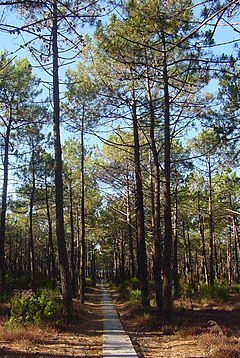Pinus pinaster
| Pinus pinaster | |
|---|---|
 |
|
 |
|
| Scientific classification | |
| Kingdom: | Plantae |
| Division: | Pinophyta |
| Class: | Pinopsida |
| Order: | Pinales |
| Family: | Pinaceae |
| Genus: | Pinus |
| Subgenus: | Pinus |
| Species: | P. pinaster |
| Binomial name | |
|
Pinus pinaster Aiton |
|
 |
|
| Distribution map | |
Pinus pinaster, the maritime pine or cluster pine, is a pine native to Mediterranean region.
P. pinaster is a hard, fast growing pine containing small seeds with large wings. P. pinaster is located in the Mediterranean basin. It favors a Mediterranean climate, which is one that has cool, rainy winters and hot, dry summers.
The native area that this species of pine, Pinus pinaster, originates from is the Mediterranean Basin, i.e. Northern Tunisia, Algeria, and Morocco.
P. pinaster is a popular topic in ecology because of its problematic growth and spread in South Africa for the past 150 years after being imported into the region at the end of the 17th century (1685-1693). It was also found spreading in Cape Peninsula by 1772. Towards the end of the 18th century (1780), P. pinaster was widely planted, and at the beginning of the 19th century (1825-1830), P. pinaster was planted commercially as a timber resource and for the forestry industry. The pine tree species invades large areas and more specifically fynbos vegetation. Fynbos vegetation is a fire-prone shrubland vegetation that is found in the southern and southwest cape of South Africa. It is found in greater abundance close to watercourses.Dispersal, habitat loss, and fecundity are all factors that affect spread rate. The species favors acidic soils with medium to high-density vegetation. but it can also grow in basic soils and even in sandy and poor soils, where only few commercial species can grow.
The range extends from Portugal and Northern Spain (especially in Galicia) to southern and Western France, east to western Italy, Croatia and south to northern Morocco. It generally occurs at low to moderate altitudes, mostly from sea level to 600 m, but up to 2000 m in the south of its range in Morocco. The high degree of fragmentation in the current natural distribution is caused by two factors: the discontinuity and altitude of the mountain ranges causing isolation of even close populations, and human activity.
...
Wikipedia

